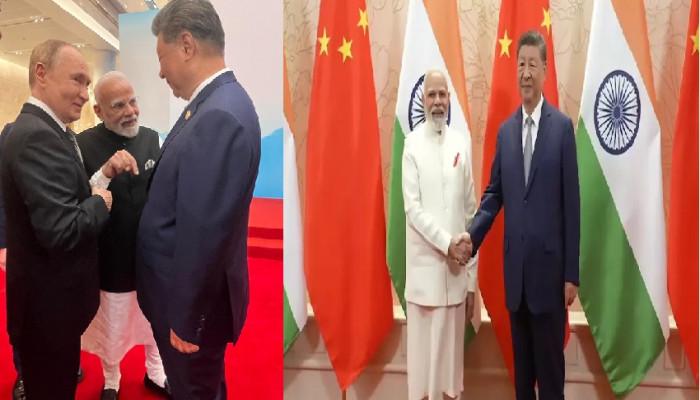India’s Assertive Diplomacy Takes Centre Stage at Tianjin
- In Foreign Policy
- 01:10 AM, Sep 05, 2025
- Ramaharitha Pusarla
PM Modi visited China after a gap of seven years to attend the 25th Shanghai Cooperation Organisation (SCO) meeting at Tianjin. His participation at the SCO Summit has been more or less regular; however, the 2025 SCO Summit dominated the headlines of international media. Coming in the wake of Trump’s extortionist tariffs on India and PM Modi’s refusal to capitulate, his engagement with SCO leaders, especially with President Xi and President Putin, has stimulated outsized attention.
Cutting through the clutter of op-eds galore, it is vital to decipher the prominence of his trip to Tianjin. Miffed by India’s defiance, the MAGA extremists have especially been egregiously presumptuous about the India-China reset at Tianjin. But PM Modi’s enthusiastic presence at the SCO has several facets to it.
Restabilisation of ties with China post-Galwan clashes began in October 2024 after the complete disengagement of troops in Eastern Ladakh. At the Kazan BRICS meeting, leaders agreed to “explore a fair, reasonable and mutually acceptable solution to the boundary question”. Subsequently, India and China held the 23rd round of talks of Special Representatives of India and China on the Boundary Question (SR) in December 2024 after a gap of five years. SR Dialogue was suspended after the Galwan clashes. The last SR Dialogue was held in New Delhi in December 2019.
During the border standoff along the LAC, discussions at the diplomatic level were conducted through the Working Mechanism for Consultation and Coordination on India-China Border Affairs (WMCC) and its military counterpart Senior Highest Military Commanders Meeting (SHMC). 17 rounds of WMCC and 21 rounds of SHMC meetings took place during the entire duration of disengagement.
The latest round, the 34th iteration of WMCC in July, “expressed satisfaction with the general prevalence of peace and tranquillity in the border areas, leading to gradual normalisation of bilateral relations”. The 24th round SR talks in August, steered by India’s Ajit Doval and China’s Wang Yi, agreed on- “Setting up an Expert Group, under the Working Mechanism for Consultation and Coordination on India-China Border Affairs (WMCC), to explore Early Harvest in boundary delimitation in the India-China border areas”. Additionally, they announced the resumption of direct flights, facilitation of visas and trade & investment flows, expansion of Mt. Kailash Yatra and re-opening of border trade through Lipulekh Pass, Shipki La Pass and Nathu La Pass.
A cautious normalisation of ties with China is already underway. Hence, the portrayal of PM Modi and President Xi’s meeting being propelled by Trump’s trade tantrums is misplaced. However, tariff weaponisation has inadvertently catalysed a recalibration. Making no secret of the tenuous global trade landscape, at the bilateral talks, Xi said, “The world today is swept by once-in-a-century transformations. The international situation is both fluid and chaotic. China and India are two ancient civilisations in the east, we are the world’s two most populous countries, and we are also the oldest members of the Global South”.
For more than four years, India has diligently engaged in multiple rounds of dialogue with China, aiming for a full withdrawal of troops from the friction points- Demchok and Despang. Drawing lessons from earlier missteps, India has recalibrated its diplomatic approach with greater precision. China's strategy of prolonged negotiations—often designed to wear down its adversaries—demands unwavering patience and resilience. Through patient and persevering diplomacy, India has ultimately succeeded in breaking through the impasse. Hence, Xi understands that India is not an easy pushover. Beijing only respects strength. India’s defiance and resistance to Trump’s unwarranted economic coercion is a signal not only to Washington, but to Beijing also.
Entangled in a trade war with the US, China believes that a temporary reset with India is in its best interest. Battling with poor domestic consumption, trade imbalances, an ageing population and pension liabilities, China is keen on ramping up economic engagement with India. This aligns with India’s attempts to diversify trade to offset tariff pressure and strengthen its manufacturing capabilities. Given India’s size, growth potential and expanding markets, China is forthcoming about rapprochement with India. While Washington chose not to accept this reality to its detriment, Beijing is quick to grasp this.
Post-SCO, global media is awash with pictures of bonhomie between the leaders of India, Russia and China. Finnish Prime Minister Alexander Stubb warned, “My message, not only to my European colleagues, but especially to the United States, is that if we don't derive a more cooperative and dignified foreign policy towards Global South, the likes of India, we are going to lose this game”. The emergence of a vibrant Global South can no longer be ignored. Xi’s implicit reference to India and China as members of the Global South underscores the same.
Hinting at recalibration, PM Modi stated, “A stable relationship and cooperation between India and China and their 2.8 billion people on the basis of mutual respect, mutual interest and mutual sensitivity are necessary for the growth and development of the two countries, as well as for a multipolar world and a multi-polar Asia befitting the trends of the 21st century”. Interestingly, PM Modi’s subtle invocation of Asian solidarity for a constructive partnership finds a resonance with President Xi’s summary statement, “It is the right choice for both sides to be friends who have good neighbourly and amicable ties, partners who enable each other’s success, and to have the dragon and the elephant dance together”.
The diplomatic trope, “the dragon and the elephant dance together”, has been more flourish than reality. However, the affirmation from leaders that “the two countries were development partners and not rivals, and that their differences should not turn into disputes”. While India is willing to be a partner in reshaping Asian destiny, its discomfort with China runs deep. India treats both China’s weaponisation of strategic supplies like speciality fertilisers, rare-earth magnets, and tunnel boring machines and Trump’s tariffs and secondary sanctions with equal scepticism and distrust.
Though India is reconsidering the FDI cap and easing its position on Chinese investment in the electronic manufacturing sector to jack up production, it is equally wary of Beijing’s economic entrenchment. The unresolved border dispute, recurring standoffs, blatant violation of mutual agreements, together with Beijing’s containment policy of India, geopolitical competition in the strategic Indian Ocean Region, continue to remain persistent irritants in the relationship.
Beijing’s attempts to emerge as a reliable foreign force in South Asia through its informal tracks with Myanmar and promotion of multilaterals between Pakistan, Afghanistan, and Bangladesh haven’t escaped India’s attention. China has drawn the Maldives, Nepal, Myanmar, and Sri Lanka into the SCO and is pushing Bangladesh to join. Alongside, Beijing is also weaving an alternative to SAARC without India in the South Asian region.
China's military intelligence support to Pakistan during Operation Sindoor, along with its repeated obstruction of UN sanctions against the Resistance Force (TRF) and its veto of global terrorist designations for five Pakistani nationals at the UNSC, continues to serve as a stark warning to Indian policymakers. These actions highlight the complex web of geopolitical alignments, where India’s current decisions are shaped not just by regional concerns but by the broader strategic calculus of global power dynamics.
Trump’s untrammelled bullying is shifting the world order. Seeking self-reliance and diversification, India is expanding its engagements and recalibrating ties. However, India is redefining relationships on its own terms. PM Modi has unequivocally conveyed India’s commitment to a “multipolar world and multipolar Asia” in talks with Xi. Stealing the light at the SCO with his infectious camaraderie, PM Modi certainly earned unusual approval from the Chinese.
Good optics make for better signalling. In geopolitics, appearances are important. Body language, symbolic gestures and display of bonhomie all have a role to play. The grand display of camaraderie at Tianjin, with three leaders of the top four countries chatting and clasping hands, went beyond symbolism. The coming together of PM Modi, President Putin and President Xi sparked the notion of a potential alternate world order.
India-Russia-China cordiality has grabbed headlines with US hawk Navarro accusing India of “getting in bed with two biggest authoritarian dictators in the World: Putin and Xi Jinping”. This kind of criticism reflects a poor understanding of India’s foreign policy dynamic. Unlike the modern-day Nation-States, India is a civilisational power which builds solid relationships for the long term and from the perspective of a worldview. Impetuosity is foreign to it, and it resists making decisions in a huff. National interests have always been paramount.
India has resolutely safeguarded its interests and continues to do so. In a major diplomatic win, the SCO condemned the Pahalgam attack and backed India’s stand to bring the perpetrators to justice. Earlier, at the SCO Defence Ministers Meeting, India refused to sign a joint declaration for diluting Indian stance on terrorism and for not mentioning cross-border terrorism.
Enunciating India’s vision for SCO as Security, Connectivity and Opportunity, PM Modi stated, “We believe that every effort towards connectivity must uphold the principles of sovereignty and territorial integrity. Connectivity, that by-passes sovereignty, ultimately loses both trust and meaning”, and once again refused to endorse China’s Belt and Road Initiative (BRI). Evidently, India refuses to make any concessions to China in pursuit of stable relations with China. This underscores the strength of India’s fiercely independent foreign policy, firmly anchored in safeguarding its core interests.
Fundamental differences exist between India and China. Beijing has to demonstrate its commitment through specific actions; grand verbosity can no longer work. The burden of sustaining this new reset is on China now. India has clear redlines and its foreign policy is rooted in its commitment to democratic values, the rule of law, and pluralism. This was clearly reflected in PM Modi’s absence at China’s Victory parade marking 80 years of World War II after the SCO Summit. Beijing sought to use the parade to mobilise national sentiment to position itself as Asia’s pre-eminent power. Indian participation would have positively legitimised China’s pursuit of domination.
The tariff war against India is an epic blunder of Trump’s foreign policy. This miscalculation allowed India and China to explore a partnership rising above differences. India has always rejected imperial tendencies and rigid groupings. Asserting independence, India is diversifying its relationships. The rubric of geopolitics is changing; the old order of alliances and kowtowing is passe. Multi-alignment and geopolitical hedging have come to dominate international relations.
India rejects the unipolarity of the US and the unilateralism of China. Amid Trump’s hardball approach, defining a clear sense of its own interests, India is affirmatively asserting its strategic multi-alignment.
References
- Statement by External Affairs Minister, Dr. S. Jaishankar in Rajya Sabha
- Prime Minister's bilateral meeting with Chinese President Xi Jinping (August 31, 2025)
- https://www.mea.gov.in/press-releases.htm?dtl/40016/Visit_of_Chinas_Foreign_Minister_and_Special_Representative_on_the_IndiaChina_boundary_question
- https://www.mea.gov.in/press-releases.htm?dtl/39819/34th_Meeting_of_the_Working_Mechanism_for_Consultation__Coordination_on_IndiaChina_Border_Affairs_July_23_2025
- English Translation of Prime Minister's statement during the 25th SCO Summit (September 01, 2025)







Comments